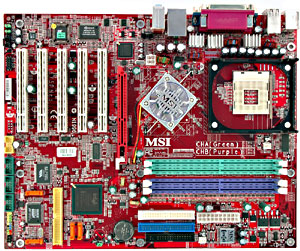MSI 875P Neo-FIS2R Mainboard (i875P)
|
This board is top in the Neo series - the series which is going to provide
any support for a user in experiments with Pentium 4 processors on the 800MHz
bus. Accessories: - Package of the standard design;
- Documentation:
user manual, installation manual for IDE RAID, PC assembly instruction - all in
English
- Cables: 4 SATA, 1 ATA66/100/133 covered with red cambric and
FDD;
- 2 power supply splitters for SATA hard drives;

-
Bracket with 3 FireWire ports;
- D-Bracket (2 USB + 4 LEDs for POST procedure);
-
Bracket with S/PDIF-Out connectors (TosLink and Coaxial);
- Blank bracket;
-
Diskette with drivers for IDE RAID;
- 2 CDs with:
- drivers;
-
Adobe Acrobat Reader;
- Adobe Photoshop Album SE;
- FarStone Virtual
Drive;
- FarStone RestoreIT!;
- InterVideo WinDVD;
- InterVideo
WinRip;
- MediaRing Dialer;
- MSI DVD;
- MSI Fuzzy Logic
(CPU auto overclocking);
- MSI GoodMem (memory optimization);
-
MSI InfoView (info on system devices);
- MSI i-Speeder (optimization of
the Internet access and monitoring of network connections);
- MSI Live
Update 2 (auto update of drivers and BIOS);
- MSI LockBox (PC access lock);
-
MSI Password Keeper;
- MSI PCAlert IV (system monitoring);
- MSI
SecureDoc (file encryption);
- MSI SmartKey.

The weak point of the board is that the additional IDE and SATA connectors
are placed behind PCI slots, and there are several connectors pressed to the left
side. Besides, it can be difficult to reach the only jumper when the board is
already installed. Its functions are not shown on the textolite. The
3-channel switching voltage regulator incorporates 8 capacitors of 1800 uF and
several less capacious ones. There is also a voltage regulator for the AGP bus
(3 capacitors of 1500 uF) and for the memory (4 of 1000 uF). Integrated controllers:
- audio controller based on the chipset and Analog Devices AD1980 codec;
5.1 audio system supported, front audio-outs and SPDIF connectors provided;
-
network controller based on the Intel 82547EI (Kenai II CSA) chip, 10BaseT/100BaseTX/1000BaseT
(Gigabit Ethernet) supported;
- IDE RAID controller on the Promise PDC20378
chip supporting RAID 0 and 1 on the ATA133 and SATA150 protocols (for 1 ATA +
1 SATA or 2 SATA devices);
- FireWire bus controller based on the VIA VT6306
chip with the support of 3 ports.
The board incorporates MSI's CoreCell
chip for realization of such functions as adjustment of the CPU voltages in small
steps up to very high values, automatic slowdown of fans when the system stands
idle, voltage monitoring etc.

Non-unsoldered
connectors: none. System monitoring is supported by Winbond W83627HF-AW chip.
It controls: - processor voltage, +3.3, +-5 and +-12 V, VBAT and +5
V Standby;
- speed of 2 fans;
- temperatures of the processor
(built-in sensor) and the board (built-in sensor).
There are 2 connectors
for adjustable and 1 for unadjustable connection of fans (it's connected to a
fan on the MCH's heatsink). Brief board's characteristics: memory
slots - 4 DDR SDRAM; expansion slots - AGP/ 5 PCI; I/O ports - 2 COM/ LPT/ 2 PS/2/
8 USB 2.0 / 3 FireWire; dimensions - 305x245 mm.

Settings:
| jumpers and switches |
CMOS Clear jumper |
|
| BIOS based on AMI v3.31a |
Setup of memory timings |
+ |
CAS Latency (the only working value was 2.5), RAS Precharge,
RAS to CAS Delay, Precharge Delay, Burst Length |
| Setup of memory frequency |
+ |
Auto; DDR266 at FSB 100 MHz; DDR266, DDR333, DDR354 at FSB 133
MHz; DDR266, DDR333, DDR400, DDR500, DDR532 at FSB 200 MHz |
| Setup of AGP bus |
- |
|
| Setup of PCI bus |
+ |
|
| Changeable scaler of AGP and PCI buses |
+ |
AGP(PCIx2) = 66-151 MHz in 1MHz steps |
| Manual assignment of interrupts |
- |
|
| Changeable FSB frequency |
+ |
100-500 MHz in 1MHz steps |
| Changeable CPU multiplier |
+ |
x8-x32 |
| Changeable core voltage |
+ |
1.1-2.3 V in 0.0125 V steps up to 1.6V and then in 0.1V steps |
| Changeable memory voltage |
+ |
2.5-3.3V in 0.05V steps |
| Changeable chipset voltage |
- |
|
| Changeable AGP bus voltage |
+ |
1.55-2.1V in 0.05-0.1V steps |
We used the BIOS 1.3B2 as the latest available version. This
is an excellent board regarding its accessories and functions, and the range of
voltage values is so wide that we do not recommend you use it in full measure
unless you realize possible consequences. Test results:
Write a comment below. No registration needed!
|
|




